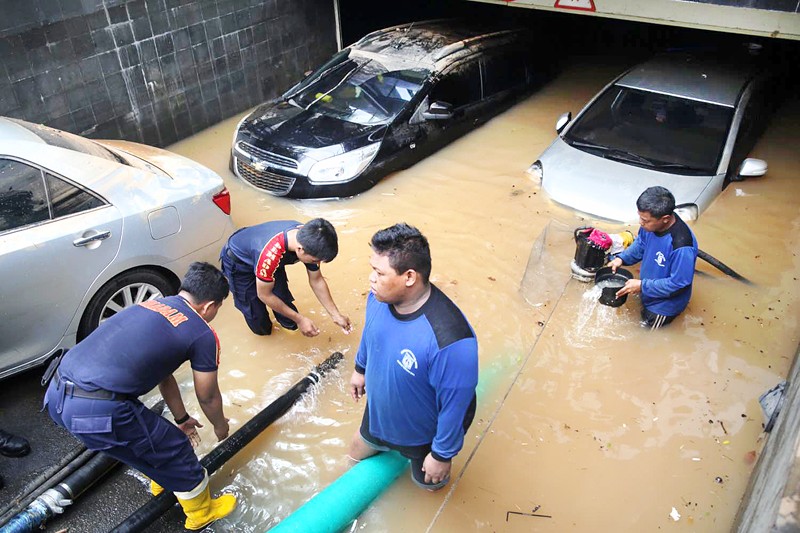Popular Reads
Top Results
Can't find what you're looking for?
View all search resultsPopular Reads
Top Results
Can't find what you're looking for?
View all search resultsCity policy causing floods
Change text size
Gift Premium Articles
to Anyone
 Clean-up: Security officials set up pumps to clear flood water from the basement of a shopping complex in Kemang, South Jakarta, on Sunday. Heavy rains had led to the overflow of the local Krukur River and caused up to 1.7-meter deep flooding in several areas of Kemang and other areas on Saturday. (JP/Wendra Ajistyatama)
Clean-up: Security officials set up pumps to clear flood water from the basement of a shopping complex in Kemang, South Jakarta, on Sunday. Heavy rains had led to the overflow of the local Krukur River and caused up to 1.7-meter deep flooding in several areas of Kemang and other areas on Saturday. (JP/Wendra Ajistyatama)
T
he flooding that has hit upscale areas in the capital, including Kemang, South Jakarta, is the result of poor spatial planning and water management.
Heavy rains poured on the city for more than an hour on Saturday afternoon causing floods of between 30 and 70 centimeters in depth and severe traffic congestion.
In the commercial area of Kemang, many visitors had to abandon their vehicles trapped in flooded basements of cafes and restaurants.
The owners eventually reclaimed their waterlogged vehicles on Sunday morning after the Jakarta Water Management Agency deployed pumps to siphon the water from the basements.
Saturday’s floods inundated many neighborhoods in the municipality, as residents enjoyed their weekends at home with their families.
Entrepreneur Duncan Gray, 42, and his family, for example, had just arrived at his house in South Cipete in the afternoon when the heavens opened. Duncan’s home, in which he has lived since he was a child, flooded for the first time on Saturday.
“Within 15 minutes, water reached my living room and kept increasing,” Duncan said, adding that the water inundated his home to a depth of around 60 centimeters.
Duncan and his family were forced to retreat to the second floor for the night.
Like Duncan, Farabi, a 26-year-old resident of North Cipete, also in South Jakarta, had to spend Saturday with his family on the second floor as the floodwaters inside his house rose to almost 80
centimeters.
“We stayed upstairs when the water started flooding our house at around 4.30 p.m.,” he said.
He added the water levels on the roads had reached up to 1.7 meters leaving most houses in the neighborhood inundated.
“Some of my neighbors had to go to stay with relatives,” said Farabi.
He blamed the flooding on the exploitative and environmentally unfriendly development of Kemang. “I hope the government will be able to crack down on the developers who are violating regulations.”
Responding to the crisis, Jakarta Governor Basuki “Ahok” Tjahaja Purnama claimed that the severe flooding was caused by the collapse of the walls of houses occupying Krukut River banks.
“It [the flooding] was caused by the collapse of the walls of houses along the Krukut River,” Ahok was quoted by kompas.com as saying on Sunday. He said he wanted to acquire the houses, but most of them had land-ownership certificates.
Asked whether his administration would impose sanctions on developers of apartments and a large shopping mall in the area, which are widely believed to have contributed to the worsening floods, Ahok rejected the idea.
“We cannot impose any sanctions. But if they have yet to fulfill their promises to build water-catchment reservoirs, we can insist they [do so],” he said.
Separately, Teguh Hendrawan, head of the water management agency, admitted that the administration had failed to anticipate the floods as it had not dredged the river for some years. The river had become shallow as a result of a build-up of mud and, hence, it could not accommodate the volume of water when the rains came.
Teguh further said that to prevent any recurrence, the administration would start dredging the river.
Aside from that, the administration will also carry out inspections as it is suspected that many green areas in the municipality have been built over for commercial or even upscale residential areas, thus reducing the ability of the land to absorb excess rainwater.
“If you take a look along the river, you will see how the river is constricted because of housing development. We will examine whether development permits have been violated,” Teguh added.
Meanwhile, urban planning expert at Trisakti University, Nirwono Joga, suggested the administration should make use of yards in residential and commercial areas in the capital as water absorption areas so that rainwater could be stored under the soil, instead of eroding it.
He said that the administration should then naturalize 13 rivers in the capital, instead of regularizing them or installing concrete walls along the banks.
Like Nirwono, water and hydrology expert, Fatchy Muhamad said that river regularization was a mistaken concept in the mitigation of flooding in the city because rainwater ran directly from upstream areas. “No matter how large the river is, it will not able to contain all the water,” he said.
He said that to deal with flooding, Jakarta needed more absorption pits, catchment reservoirs and biopore holes in order to contain the water.
“We [in Jakarta] still have enough underground space to absorb the water,” he said adding that later the water would be beneficial for people in the dry season. (sha)
_____________________________
To receive comprehensive and earlier access to The Jakarta Post print edition, please subscribe to our epaper through iOS' iTunes, Android's Google Play, Blackberry World or Microsoft's Windows Store. Subscription includes free daily editions of The Nation, The Star Malaysia, the Philippine Daily Inquirer and Asia News.
For print subscription, please contact our call center at (+6221) 5360014 or subscription@thejakartapost.com









